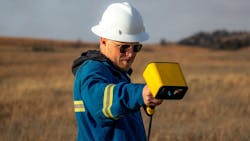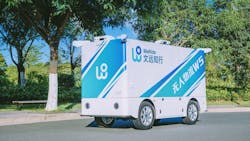Manufacturing's Latest Firsts: ANSI's New Bump Cap Standard, Delivery Vehicles Get Level 4 Tech, EPA Approves Methane Detector, and More
Key Highlights:
- ANSI introduces ANSI/ISEA 100-2024 standard for bump caps, addressing gaps in head protection and providing clear guidelines for manufacturers.
- Smoltek cuts iridium use by 95% in PEM electrolyzers by developing a porous transport electrode, enabling cost-effective production for green hydrogen.
- WeRide launches Robovan W5 as the first Level 4 autonomous delivery vehicle, offering 24/7 urban logistics and high-capacity performance.
- EPA approves Xplorobot's methane detector as an alternative test method, setting a new standard for methane detection.
- DataBeyond debuts AI fabric sorter with 99% accuracy, improving textile recycling and raw material recovery.
Manufacturing Firsts is a recurring round-up where each installment will spotlight technological and manufacturing innovations that represent genuine "firsts" in their respective industries. We'll explore breakthrough developments that signal important shifts in how companies design, engineer, and produce cutting-edge products.
New U.S. Standard Set for Industrial Bump Caps
Closing the gap for head protection standards in the industry, the American National Standards Institute (ANSI) has approved the ANSI/ISEA 100-2024 standard for bump caps, giving manufacturers consistent guidelines for classification, testing, and performance requirements for bump caps.
Prior to this standard, there was no U.S. benchmark for bump caps, so manufacturers often looked to the European standard, EN812, which has limitations. The new ANSI/ISEA 100 standard provides testing and language clarity that accommodates various designs, including bump cap inserts that can be used with different types of headwear, from baseball caps to winter hats. It also shares similar performance requirements with EN812 but allows greater flexibility in design.
ISEA President & CEO Cam Mackey noted that ANSI/ISEA 100-2024 is not a replacement for products covered by ANSI/ISEA Z89.1.
A copy of ANSI/ISEA 100-2024 is available from ISEA online at safetyequipment.org/our-standards/.
EPA Approves Xplorobot's Handheld Methane Detector as an Alternative Test Method
Xplorobot's Laser Gas Imager has been approved by the United States Environmental Protection Agency (EPA) as an Alternative Test Method (ATM) for methane inspections, marking the first-ever approval of a handheld mobile methane detection device, setting a new standard for efficiency and affordability in emissions monitoring.
Using Tunable Diode Laser Absorption Spectroscopy (TDLAS) and high-resolution imaging, the Xplorobot Laser Gas Imager detects emissions as small as 1 g/h. Technicians don't need to be certified to use it and it automates data analysis, generating methane emissions visualizations and digitally confirming zero emissions at the component level to meet EPA's OOOO a/b/c and Subpart W, the European Union Methane Regulations, and the United Nations Environment Programme's (UNEP) Oil and Gas Methane Partnership 2.0 (OGMP2.0) compliance requirements.
With EPA approval secured, Xplorobot is ramping up deployments and seeking partnerships with service companies to deploy the Laser Gas Imager at scale. To join, visit xplorobot.com or reach out to [email protected] to set up an introduction call.
Smoltek's Iridium Breakthrough for PEM Electrolyzers
Smoltek Nanotech Holding AB has developed a porous transport electrode (PTE) that uses only 0.1 mg of iridium catalyst per square centimeter in PEM electrolyzers, representing a 95% reduction compared to conventional technology, which typically uses around 2 mg/cm².
This achievement addresses one of the hydrogen industry's most significant challenges—the limited availability of iridium, which has been a major obstacle to large-scale manufacturing of PEM electrolyzers. The company successfully tested its technology in a 250-hour continuous operation durability test at 2 A/cm² without any degradation of the electrolyzer cell's nanostructure.
Reaching the 0.1 mg/cm² threshold is considered crucial for making large-scale production of PEM electrolyzers profitable, particularly for green hydrogen production using intermittent energy sources like solar and wind power.
Smoltek's breakthrough is expected to significantly reduce the costs of producing PEM cells and help accelerate the global growth of green hydrogen production.
Robovan W5 Debuts as First Autonomous Delivery Van With Level 4 Tech
WeRide, Inc. (NASDAQ: WRD) has unveiled the Robovan W5, a first-of-its-kind autonomous delivery vehicle that combines Level 4 autonomy, urban open-road capability, and high-capacity logistics performance into a single platform. Designed to operate 24/7 in all weather conditions, the Robovan W5 aims to solve key challenges in express delivery, urban distribution, and point-to-point logistics with a fully unmanned, cost-effective solution.
Built on nearly 40 million kilometers of public-road autonomous driving experience, the W5 features a redundant sensor suite offering 360-degree, blind-spot-free perception. It supports multivehicle platooning that allows a single operator to manage a fleet, and integrates cloud-based intelligent scheduling, route optimization, and real-time monitoring. With a 5.5 cubic meter cargo capacity, 1,000 kg payload, and up to 220 kilometers of range, it has the largest load capability in its class.
Additional features include modular cargo box stacking, an electric drivetrain, intelligent path planning, and a suite of safety redundancies such as emergency braking and collision warnings. The Robovan W5 is supported by WeRide's cloud platform for OTA updates, fleet analytics, and customer service, positioning it as a comprehensive and scalable autonomous delivery solution for high-frequency urban logistics.
DataBeyond's AI-Powered Fabric Sorter Sets New Standard for Textile Recycling
DataBeyond Technology has officially launched China's first AI Hyperspectral Optical Sorter for Blended Fabrics, integrating advanced artificial intelligence algorithms with hyperspectral recognition technology. This development addresses the challenge of sorting mixed fabrics with complex material compositions.
The system separates fabrics containing polyester, nylon, spandex, and cotton, achieving sorting accuracy rates of up to 99%, helping keep more textiles and garments out of landfills or incinerated. It can handle a wide range of items and can be quickly reconfigured to meet changing sorting needs, helping recyclers recover high-quality raw materials for chemical recycling.
Equipped with sensors that capture 256 spectral bands, the sorter allows for full-spectrum recognition and flexible adjustment to different sorting targets. Developed over seven years, the technology represents a milestone in textile recycling and is expected to open new profit opportunities for the industry while accelerating the shift toward smart recycling.
About the Author
Laura Davis
Editor-in-Chief, New Equipment Digest
Laura Davis is the editor in chief of New Equipment Digest (NED), a brand part of the Manufacturing Group at EndeavorB2B. NED covers all products, equipment, solutions, and technology related to the broad scope of manufacturing, from mops and buckets to robots and automation. Laura has been a manufacturing product writer for eight years, knowledgeable about the ins and outs of the industry, along with what readers are looking for when wanting to learn about the latest products on the market.


